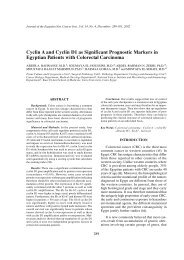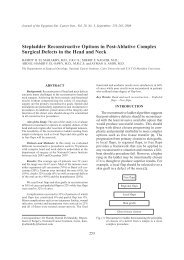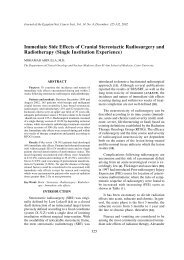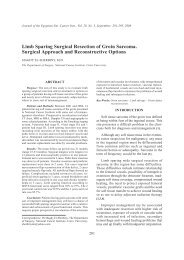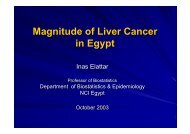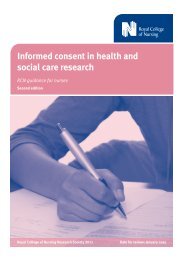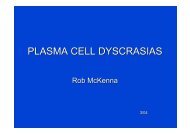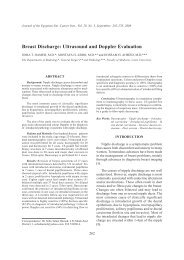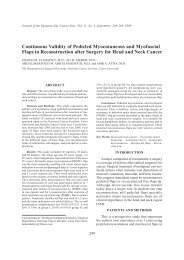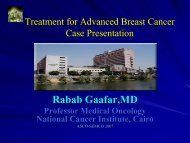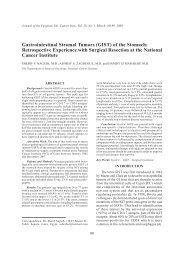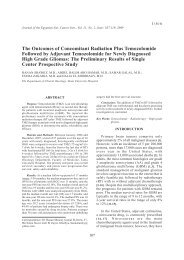Full Text pdf - NCI
Full Text pdf - NCI
Full Text pdf - NCI
You also want an ePaper? Increase the reach of your titles
YUMPU automatically turns print PDFs into web optimized ePapers that Google loves.
13th Congress of the European Hematology Association, June 12-15, 2008Haematologica 2008: 93(s1):222 Abs.0548SEQUENTIAL MOLECULAR MONITORING OF PATIENTS WITH CHRONIC PHASE MYELOGENOUS LEUKEMIADURING IMATINIB MESYLATE TREATMENT. CLINICAL SIGNIFICANCE AND PREDICTIVE VALUEH. Kamel 1 , Y.El-Nahas 1 , M. Abdel Moaty 1 , R. Abdel Fattah 1 , M. El Emary 2 , W. ElMetnawy 31National Cancer Institute, Cairo University, Egypt; 2Nasser Institute , Ministry of Health , 3Medical School, Cairo University, EgyptBackground and Purpose. To determine the value of regular sequential determinations of bcr-abl transcripts by RT Q-PCR in identifying thepattern of long term response to IM in Egyptian patients with chronic phase CML, correlation with hematologic andcytogenetic response.Patients and Methods. Seventy five Egyptian patients with CP CML , treated with a daily oral dose of IM 400 or 600mg were followed for amedian follow up (FU) period of 20.6 months ( range 6-43 months) . RT Q-PCR was performed at regular intervals every 3 months during thewhole FU period ,cytogenetic analysis by conventional karyotyping or FISH was performed every 3 or 6 months.Results. The median Bcr-Abl/Abl ratio before the start of therapy was 12.3 (range: 0.23-20). Analyses of the results showed that 70 patients(93%) had hematologic response, 53 patients ( 70%) achieved partial and complete cytogenetic response (PCR &CCR) by 12 months. Amongthese 53 patients only 36 patients (48%) who achieved major molecular response (3 log reduction from initial Bcr-Abl/Abl ratio), and Bcr-Abltranscripts became undetectable in 19 (25%) of them through 24 months follow up period with more than 4.5 log reduction from initial Bcr-Abl/Ablratio upon consecutive measurements. Four patients (5%) attained major molecular response (3 log reduction ) after 18 months and wereconsidered late responders. A suboptimal response was observed in 13 patients (17%) who maintained 2 log reduction with partial cytogeneticresponse along 18-43 months follow up, and five of them demonstrated a reincrease of Bcr-Abl transcripts as detected by Q-RT PCR .Only oneof the 5 patient could gain major molecular response upon increasing the dose of IM to 600 mg. Primary resistance was observed in 18 (24%) ofthe 75 patients who have not demonstrated any molecular or cytogenetic response since the start of treatment. Study of the Abl kinasemutations. T 315 I, F 311 L , E 255 K and the M 351 T was performed by ASO PCR in 12 patients. The M 351 T mutation was found in 3 casesout of 7 with primary resistance, the same mutation was also found in one out of 3 patients with suboptimal response. One patient relapsedduring treatment did not have any of the studied mutations but had clonal evolution with acquisition of a new chromosomal abnormality.Conclusions. Molecular monitoring of Bcr-Abl transcripts during IM treatment of patients with CP CML is a reliable predictive method of thecourse 35 of the disease. The inferior response to IM in this sample of Egyptian population may be either attributed to the limited sample size ormore likely, to differences in biology from the western population.



